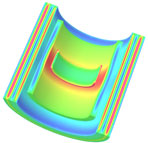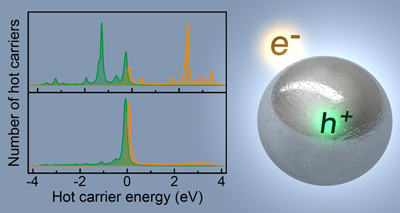The first complete theory of how plasmons produce "hot carriers" has been developed by researchers in the US. The new model could help make this process of producing carriers more efficient, which would be good news for enhancing solar-energy conversion in photovoltaic devices, making better photocatalysts and for applications like water splitting to produce hydrogen, to name but a few.
Plasmons are quantized collective oscillations of conduction electrons on the surface of metallic nanostructures that interact strongly with light. Such enhanced interaction allows them to concentrate light into subwavelength volumes, well below the diffraction limit of light. The phenomenon could be put to good use in a range of technologies, such as light detection and modulation, optical communications, photovoltaics and spectroscopy.
Surface plasmons only live for a short while, after which they either decay radiatively by emitting a photon or non-radiatively by generating electron–hole (charge carrier) pairs, explains team leader Peter Nordlander from Rice University. In the non-radiative case, hot charge carriers are produced. These carriers are electrons and holes that have been excited by photons with high energies.
Capturing hot-carrier energy
In bulk materials, hot carriers quickly cool in a matter of picoseconds, releasing phonons (vibrations of the crystal lattice, or heat). Indeed, such wasted heat can account for up to 50% of the energy losses in present-day solar cells. If the energy of hot carriers could be captured before it converts into wasted heat, solar-to-electric power-conversion efficiencies might be greatly increased.
Hot carriers can also induce chemical reactions – that would otherwise be too energetically demanding – in molecules near the surface of plasmonic nanostructures. Such reactions might help in water splitting, for example. Here, water is separated into oxygen and hydrogen using sunlight, which is a clean and renewable way to produce energy. They might also be used to transfer electrons into molecules or structures nearby – and so act as dopants.
Simple model
To fully exploit these carriers for such applications, researchers need to understand the physical processes behind plasmon-induced hot-carrier generation. Nordlander's team has now developed a simple model that describes how plasmons produce hot carriers in spherical silver nanoparticles and nanoshells. The model describes the conduction electrons in the metal as free particles and then analyses how plasmons excite hot carriers using Fermi's golden rule – a way to calculate how a quantum system transitions from one state into another following a perturbation.
The model allows the researchers to calculate how many hot carriers are produced as a function of the light frequency used to excite the metal, as well as the rate at which they are produced. The spectral profile obtained is, to all intents and purposes, the "plasmonic spectrum" of the material.
Particle size and hot-carrier lifetimes
"Our analyses reveal that particle size and hot-carrier lifetimes are central for determining both the production rate and the energies of the hot carriers," says Nordlander. "Larger particles and shorter lifetimes produce more carriers with lower energies and smaller particles produce fewer carriers, but with higher energies."
The team says that it has also succeeded in characterizing how efficient the hot-carrier generation process is, thanks to a figure of merit that measures how many high-energy carriers are produced per plasmon.
"Our results could help provide strategies for making the hot-carrier generation process more efficient," says team member Alejandro Manjavacas. "Indeed, we are now busy developing another theory for how hot carriers are produced in transition-metal particles and a third one that describes how the hot carriers evolve over time." Identifying the timescales involved in carrier decay will be another essential element for optimizing the carrier-generation process, he adds.
The results are published in ACS Nano.
- This article first appeared on nanotechweb.org
![[IOP]](Plasmons%20excite%20hot%20carriers%20-%20physicsworld.com_files/colophon-small.png)
















No comments yet
Be the first person to comment on this article